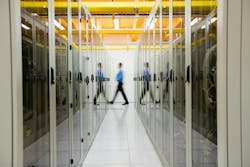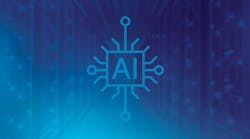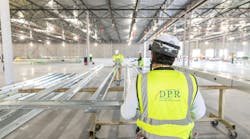AI Changed the Rules. Backup Power Hasn’t Caught Up
AI is stressing the grid, and backup power is more essential than ever. New workloads demand high-density compute, continuous uptime, and faster failover. That’s creating unprecedented pressure on power availability, particularly in regions where grid capacity is already limited.
As this demand accelerates, the role of backup power is evolving. Diesel generators, long considered a reliable failsafe, are becoming even more essential, not just as a stopgap in emergencies, but as a critical piece of a broader energy strategy.
While AI is changing how much we compute, it’s also changing how we plan for resilience. Grid limitations are driving the need for more flexible, reliable, and scalable backup systems. Diesel remains a cornerstone of the strategy and will continue to play a central role as the foundation for power security, even as other technologies emerge to complement it.
When the Grid Isn’t Enough
According to the International Energy Agency, global electricity demand from data centers, AI, and crypto could more than double by 2026, surpassing 1,000 terawatt-hours, a figure that rivals entire nations. Already, grid stability is under strain in regions where AI and hyperscale growth are concentrated.
As the DOE models new grid configurations to account for AI growth, data center operators are being left to bridge the shortfalls. That means rethinking the assumptions behind backup power, from fuel mix and emissions to run-time duration and integration with the broader energy system.
Diesel’s Evolving Role
For decades, diesel gensets have been the gold standard of data center backup. But regulations are tightening. California is pushing to restrict non-emergency diesel generator runtime to just 20 hours per year. Other regions are setting their own caps, and ESG frameworks are pressuring enterprises to phase out high-emission assets.
The challenge is that the grid can no longer keep up on its own. That’s why the industry is turning to complementary solutions, including diesel generators with proven resiliency, and other systems that operate alongside the grid in non-emergency scenarios while ensuring emergency diesel remains ready for its core role.
“In an era of 24/7 digital services and rising climate mandates, backup systems can’t rely on fossil fuels alone,” said Christiana Figueres, former Executive Secretary of the UNFCCC. “They must align with net-zero goals, not delay them.”
This isn’t a pivot away from diesel. It’s a shift in how we think about total resilience, one where backup systems, grid infrastructure, and emerging technologies each play a defined, supporting role. The bottom line: Diesel can no longer carry the full weight of resilience.
A Smarter, Cleaner, More Layered Strategy
A new generation of backup systems is emerging, one that blends reliability with flexibility and sustainability. Some recent shifts include:
- Hydrotreated Vegetable Oil (HVO): Used as a drop-in replacement for diesel, HVO can reduce lifecycle emissions by up to 90%. Compass Datacenters has already moved to adopt HVO at several U.S. sites.
- Hydrogen Fuel Cells: Major hyperscalers are actively testing hydrogen fuel cell systems to evaluate their potential for long-duration, zero-emission backup. At the same time, manufacturers and OEMs, including Rehlko, in partnership with Toyota, are exploring how hydrogen-powered generator platforms can be adapted for future data center environments.
- Microgrids and Hybrids: Clarke Energy and other providers are integrating HVO-powered generators with batteries and dynamic control platforms, allowing for real-time optimization of backup power.
Battery energy storage is also surging, with the global market projected to hit $49 billion by 2030. These aren’t theoretical solutions. They’re already being deployed and not just by hyperscalers.
The Backup Power Questions Operators Should Be Asking
Reaching for the next upgrade isn’t about checking a box. It’s about matching evolving workloads with appropriate risk strategies. Operators should be asking:
- What’s the actual runtime expectation now?
AI workloads don’t tolerate downtime, and grid events are lasting longer. Backup systems can’t just ride through short blips anymore; they need to support sustained operations, load shifts, or even full-facility continuity for hours or days. - Can our backup systems contribute to energy efficiency, not just compliance?
Backup no longer sits idle. With better controls and fuel flexibility, backup assets can support peak shaving, demand response, or emissions reductions, but only if designed with efficiency in mind. - How well do they integrate with AI-enabled controls, analytics, or renewables?
Modern energy strategies are dynamic. Backup systems that can’t communicate or coordinate with the rest of your energy stack (batteries, smart controllers, renewables) add friction and cost. - Do we have a path to phase out diesel without compromising resilience?
Regulatory and investor pressure is mounting. Having a phased roadmap, HVO, hybrid, and hydrogen gives operators optionality and helps future-proof the site.
These questions will define who’s planning for performance and who’s scrambling when demand spikes.
AI Isn’t Just the Driver. It’s the Enabler.
The irony? AI itself is helping solve the very problems it exacerbates.
At the grid level, machine learning is optimizing dispatch and load balancing. Within facilities, AI tools are improving generator maintenance, predicting failure points, and orchestrating seamless transitions between power sources. The National Renewable Energy Lab found that AI-enhanced systems improved peak load handling by up to 20%.
As AI becomes embedded in energy management systems, backup power is evolving from a siloed safety net into a fully integrated, intelligent part of the stack.
From Afterthought to Asset
The data center industry has always been defined by its ability to adapt and lead. Now, as the AI era redefines power needs at every level, backup systems can no longer be an afterthought.
They must be resilient, measurable, fuel-flexible, and smart enough to keep up.
This isn’t just a technology shift. It’s a strategic one. And the operators who act now will be best positioned to scale responsibly and sustainably into the AI-powered future.
About the Author

Nicole Dierksheide
Nicole Dierksheide is the global category leader for Rehlko’s Data Center product line. She has broad experience over her 25+ year career that spans from engineering subsystems on locomotives to marketing test and measurement equipment.
Nicole holds a degree in electrical engineering from the University of Arizona and uses her technical expertise to work with customers on finding the optimal solution for their needs. She is a sustainability champion at Rehlko and passionate about driving greener actions both at work and in her personal life.
Rehlko provides advanced backup power solutions engineered to meet the critical needs of today’s energy-intensive infrastructure. Learn more at www.rehlko.com. For further insight on evolving energy demands, read the IEA Electricity 2024 Report.



